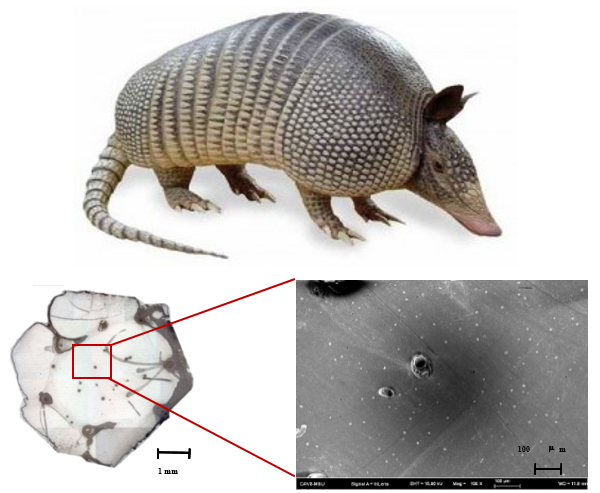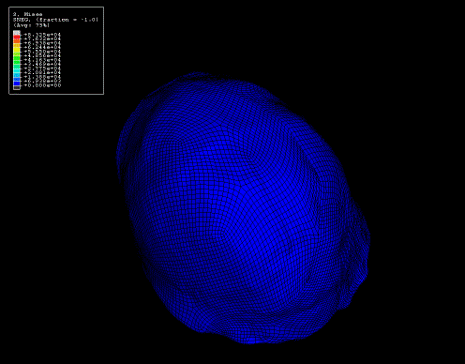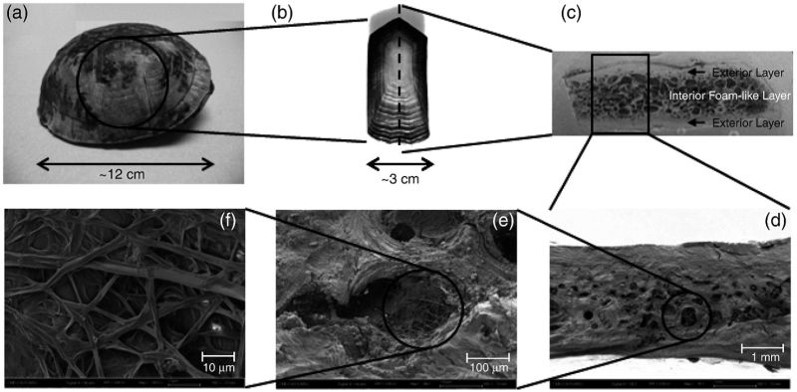Bio-Inspired Design
Bio-inspired design uses principles in nature to develop new designs. At CAVS, we are employing bio-inspired design to develop light-weighted and impact-resistant vehicles, armor and sports gear.
Instead of replicating the biological entity itself, CAVS researchers imitate and apply the design principles of biological systems to man-made systems, exploring the possibilities of incorporating it into future technology.
Ram's Horns
During fights, the rams’ horns clash together at high speeds (up to 5.5 m/s), resulting in forces up to 3400N. The remarkable resilience of horns, and the resulting well-being of the rams themselves, makes them an excellent study for CAVS researchers to investigate and understand damage-deterring mechanisms and impact- resistant materials in nature. To learn more, click the link below:
Armadillo Shell
The nine-banded armadillo’s dermal shell is characterized into three regions: the forward shell, band shell, and rear shell. The forward and rear shells comprise a sandwich-like composite structure of functionally graded material, having a relatively dense exterior bony layers and an interior bony network of foam. The forward and rear shell’s strength (~1500MPa) was found to be greater than the intermediate band shell (~500 MPa). The band shell revealed a more complicated structure, where adjacent bands are partially overlapped and connected with each other to provide flexibility and protection.

References
- Rhee H, Horstemeyer MF, Ramsay A. A study on the structure and mechanical behavior of the Dasypus novemcinctus shell. Materials Science and Engineering: C. 2011 Mar 12;31(2):363-9.
Paddlefish Rostrum
The rostrum of the paddlefish is a unique structure, comprising of a network of cartilage, tissue and interlocking star-shaped bones, called the stellate bones. The function of the long, paddle-shaped snout has received considerable attention. The sensory function of the rostrum enables them to detect the type of flows that allows the animal to feed efficiently in both laminar and turbulent currents. The sensory function also allows the paddlefish to detect tiny zooplanktons without having to use visual, chemical or hydrodynamic senses.
Tests on the rostrum shows an incredible load transfer mechanism when subjected to blast and penetration loads. Several materials have been considered to reverse engineer the unique load resistance characteristics of the rostrum to engineer superior materials that could be used for blast resistant walls and bulletproof vests.

References
- C. Gurgens, D.F. Russell, L.A. Wilkens, Electrosensory avoidance of metal obstacles by the Paddlefish. Journal of Fish Biology, 57 (2000) 277-290.
- L.A. Wilkens, D. F. Russell, X. Pei, C. Gurgens, The Paddlefish Rostrum functions as an electrosensory antenna in plankton feeding. Proc. R. Soc. Lond. B 264 (1997) 1723-1729.
- Deang, Jeremiah F., et al. "Constitutive behaviour of paddlefish (Polyodon spathula) cartilage.“ Bioinspired, Biomimetic and Nanobiomaterials 6.4 (2017): 236-243.
Turtle Shell
CAVS researchers studied various components of the turtle shell, including its multiscale structure, materials properties, and mechanical responses, to understand the fundamental knowledge of naturally occurring biological penetrator-armor systems. This systematic study could provide fundamental understanding for structure-property phenomena and biological pathways to design bio-inspired synthetic composite materials.
Structural observation and chemical analysis results revealed that the turtle shell carapace is comprised of a multi-phase sandwich composite structure of functionally graded material, having exterior bone layers and a foam-like, bony network of closed-cells between the two exterior bone layers. Although the morphology was quite different, the exterior bone layers and interior bony network possess comparable hardness and elastic modulus values of ~1 GPa and ~20 GPa, respectively.

Compression and flexure test results showed a typical nonlinear deformation behavior recognizant of man-made foams, mechanical test results revealed that the interior closed-cell foam layer plays a significant role on the overall deformation behavior of the turtle shell, and finite element analysis simulation results showed comparable agreement with the actual experimental test data.

References
- H. Rhee, M.F. Horstemeyer, Y. Hwang, H. Lim, H. El Kadiri, and W. Trim, “A study on the structure and mechanical behavior of the Terrapene carolina carapace: a pathway to design bio-inspired synthetic composites,” Materials Science and Engineering C 29 (2009) 2333-2339.
Woodpecker
Woodpeckers show amazingly efficient shock absorption capabilities without any recorded damage to their beaks or brains while pecking trees. By analyzing the woodpecker, CAVS researchers gained a deeper understanding of the energy absorption capabilities of biological structural materials’ mechanisms. To learn more, click the link below:
